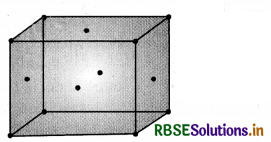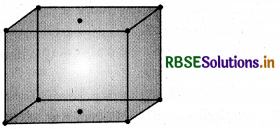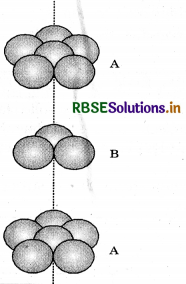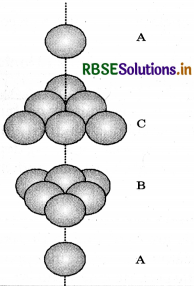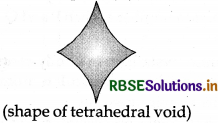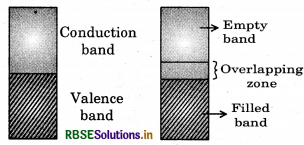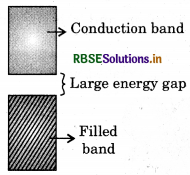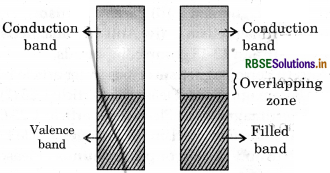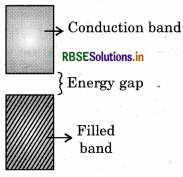RBSE Solutions for Class 12 Chemistry Chapter 1 The Solid State
Rajasthan Board RBSE Solutions for Class 12 Chemistry Chapter 1 The Solid State Textbook Exercise Questions and Answers.
RBSE Class 12 Chemistry Solutions Chapter 1 The Solid State
RBSE Class 12 Chemistry The Solid State InText Questions and Answers
Question 1.1.
Why are solids rigid?
Answer:
In solid, the constituent particles are closely arranged. They have very strong intermolecular force of attraction. Hence, they occupy fixed positions. They can only vibrate about their mean position. That is why the solids are rigid.
Question 1.2.
Why do solids have a definite volume?
Answer:
Solids have a definite volume because the constituent paf tides in solid have fixed position. Hence, they are not free to move about and they become rigid and have definite volume.

Question 1.3.
Classify the following as amorphous or crystalline solids: Polyurethane, naphthalene, benzoic acid, teflon, potassium nitrate, cellophane, polyvinyl chloride, fibre glass, copper.
Answer:
- Amorphous solids : Polyurethane, teflon, cellophane, polyvinyl chloride, fibre glass.
- Crystalline solids : Benzoic acid, potassium nitrate, copper, naphthalene.
Question 1.4.
Refractive index of a solid is observed to have the same value along all directions. Comment on the nature of the solid. Would it show cleavage property?
Answer:
As refractive index of a solid is observed to have the same value along all directions, it means solid is isotropic in nature. As amorphous solid is isotropic in nature. Hence, it would not show a clean cleavage when cut with a knife. It would break into the pieces with irregular surfaces.
Question 1.5.
Classify the following solids in different categories based on the nature of intermolecular forces operating in them. Potassium sulphate, tin, benzene, urea, ammonia, water, zinc sulphide, graphite, rubidium, argon, silicon carbide.
Answer:
(i) Molecular solids : Benzene, urea, ammonia, water, argon
- Benzene: Non-polar (London forces)
- Urea: Polar (dipole-dipole interaction)
- Ammonia: Hydrogen bonded molecular solid
- Argon: Non-polar (London dispersion force)
(ii) Ionic solids: Potassium sulphate, zinc sulphide (electrostatic force of interaction).
(iii) Metallic solids: Rubidium, Tin (Metallic bonding).
(iv) Covalent or Network solids: Graphite, silicon carbide (covalent bonding).
Question 1.6.
Solid A is very hard, electrical insulator in solid as well as molten state and melts at extremely high temperature. What type of solid is it?
Answer:
It is covalent or network solid like SiO2 (quartz), SiC, C (diamond).

Question 1.7.
Ionic solids conduct electricity in the molten state but not in the solid state. Explain.
Answer:
Ionic solids are insulator in the solid state because in solid state the ions are not free. They are held together by strong electrostatic forces of attraction. But in molten state ionic solids dissociate to give free ions, hence they can conduct electricity.
Question 1.8.
What type of solids are electrical conductors, malleable and ductile?
Answer:
Metallic solids.
Question 1.9.
Give the significance of a 'lattice point'?
Answer:
Lattice point represents one constituent particle of unit cell. The constituent particle may be atom, molecule or an ion.
Question 1.10.
Name the parameters that characterise a unit cell?
Answer:
A unit cell has following parameters:
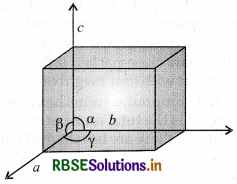
(a) Three edge length a, b, c.
(b) Three axial angle a, p, y.
Question 1.11.
Distinguish between:
(i) Hexagonal and monoclinic unit cells.
(ii) Face centred and end centred unit cells.
Answer:
(i) Differences between hexagonal and monoclinic unit cells:
|
Property |
Hexagonal unit cell |
Monoclinic unit cell |
|
1.Number of three-dimensional lattice |
1 |
2 |
|
2. Name of lattice |
Simple |
Simple, |
|
3. Edge length |
a ≠ b ≠ c |
End-centred |
|
4. Axial Angle |
α = β = 90°, γ = 120° |
a ≠ b ≠ c |
|
5. Example |
Graphite, ZnO, CdS |
α = Y = 90°, β ≠ 120° |
(ii) Differences between face centred and end centred unit cell:
|
Property |
Face-Centred unit cell |
End-Centred unit cell |
|
1. Position of lattice points |
At all the corners and at the centre of all faces |
At all the corners and at the centre of any two opposite faces |
|
2. Number of atoms per unit cell |
8 corners x 1/8 + 6(faces) x 1/2 = 4 |
8 (corners) x 1/8 + 2(faces) x 1/2 = 2 |
|
3. Figure |
|
|
Question 1.12.
Explain how much portion of an atom located at (i) comer and (ii) body-centre of a cubic unit cell is part of its neighbouring unit cell.
Answer:
(i) Portion of an atom at comer: An atom at comer is shared by eight adjacent unit cell. Four unit cells on one layer while four unit cells either above or below the layer, Hence, the portion of the atom at the corner that belongs to one unit cell is equal to 1/8.
(ii) Portion of an atom at body centre: An atom at the centre of body of a cubic unit cell is not shared by any other unit cell. Hence, it belongs the whole part or fully to the unit cell.
Question 1.13.
What is the two dimensional coordination number of a molecule in square close-packed layer ?
Answer:
Two dimensional coordination number of a molecule in square close-packed layer is equal to 4 as each atom is in contact with four neighbouring atoms.

Question 1.14.
A compound forms hexagonal close-packed strucutre. What is the total number of voids in 0.5 mol of it ? How many of these are tetrahedral voids.
Answer:
As we know that, Number of atoms in the close packing = N = 0.5 mol
Number of tetrahedral voids = 2N = 2 x 0.5 mol
Number of octahedral voids = N = 0.5 mol
Hence, total number of atoms in close packing
= 0.5 mol
= 0.5 x 6.022 x 1023
= 3.011 x 1023 atoms
Number of tetrahedral voids = 2 x 0.5 mol
= 2 x 0.5 x 6.022 x 1023
= 6.022 x 1023 = 05 mol
Number of octahedral voids = 0 5 x 6.022 x 1023
= 3.011 x 1023
Total number of voids = Octahedral voids + Tetrahedral voids
= 3.011 x 1023 + 6.022 x 1023
= 9.033 x 1023 voids.
Question 1.15.
A compound is formed by two elements M and N. The element N forms ccp and atoms of M occupies 1/3 rd of tetrahedral voids. What is the formula of the 3 compound?
Answer:
Let, number of atoms in ccp = x
Number of tetrahedral voids = 2x
Number of octahedral voids = x
As element M occupies 1/3rd of tetrahedral voids hence,
Number of M atoms = 1/3 x 2x
= \(\frac{2 x}{3}\)
As element N occupies ccp array hence,
Number of N atoms = x
Ratio of M and N M : N
= \(\frac{2 x}{3}\) : x
= 2 : 3
Formula of compound = M2N3.
Question 1.16.
Which of the following lattices has the highest packing efficiency:
1. Simple cubic,
2. Body-centred cubic and
3. Hexagonal close packed lattice?
Answer:
Packing efficiencies are as follows:
- Simple cubic = 52.4 %
- Body-centred = 68%
- Hexagonal close packed = 74%
Thus, Hexagonal close-packed lattice has the highest packing efficiency.

Question 1.17.
An element with molar mass 2.7 x 10-2 kg mol-1 forms a cubic unit cell with edge length 405 pm. If its density is 2.7 x 103 kg m-3, what is the nature of the cubic unit cell?
Answer:
Given that,
Molar mass 'M' = 2.7 x lO-2 kg mol1
Edge length 'a' = 405 pm
= 405 x 10-12 m
density 'd' = 2.7 x 103 kg m-3
Avogadro's Number 'NA' = 6.022 x 1023 mol-1
Density'd' = \(\frac{\mathrm{Z} \times \mathrm{M}}{a^3 \times \mathrm{N}_{\mathrm{A}}}\)
Z = \(\frac{d \times a^3 \times \mathrm{N}_{\mathrm{A}}}{\mathrm{M}}\)
= \(\frac{2.7 \times 10^3 \times\left(405 \times 10^{-12}\right)^3 \times 6.022 \times 10^{23}}{2.7 \times 10^{-2}}\)
= 3.99 = 4
Thus, there are four atoms of the element present per unit cell. Hence, the cubic cell must be face centred or cubic close packed (ccp).
Question 1.18.
What type of defect can arise when a solid is heated? Which physical property is affected by it and in what way?
Answer:
On heating a solid, vacancy defect is produced in the crystal because on heating some atoms or ions left its lattice site completely leaving behind a hole. Hence, due to this type of vacancy defect, density of the crystal decreases because some atoms or ions left the crystal completely and electrical conductivity increases.
Question 1.19.
What type of stoichiometric defect is shown by: (i) ZnS, (ii) AgBr?
Answer:
(i) ZnS: It shows Frenkel defect because there is a large difference in the size of ions.
(ii) AgBr: It shows both Schottky as well as Frenkel defects.
Question 1.20.
Explain how vacancies are introduced in an ionic solid when a cation of higher valence is added as an impurity in it.
Answer:
When a cation of higher valence is added to an ionic solid then impurity defect is produced. In impurity defect, two or more cations of lower valency are replaced by a cation of higher valency in order to maintain the electrical neutrality. Hence, some vacancies are created.For example : In ionic crystal of NaCl, impurity of Sr2+ is added as SrCl2. Then two Na+ ions left its lattice site leaving behind holes. One of these hole will be occupied by one Sr2+ ion to maintain electrical neutrality and other hole will remain vacant.
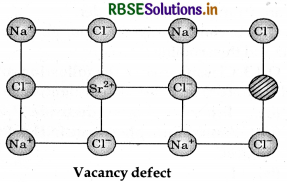
Question 1.21.
Ionic solids, which have anionic vacancies due to metal excess defect, develop colour. Explain with the help of a suitable example.
Answer:
When crystals of alkali metal halides, such as NaCl are heated in the atmosphere of sodium vapour, then the excess of sodium atoms are deposited on the surface of the crystal. The CT ions diffuse to the surface and combine with sodium atoms to form NaCl. This happens by the loss of electrons by Na atom to form Na+ ions. These released electrons diffuse into the crystal and occupy anionic sites. It is known as F-centre. F-centre is responsible to colour. Due to this F-centre, they impart yellow colour to the crystal because they absorb energy from the visible light and get excited. Similarly excess of Li makes LiCl crystal pink in colour and excess of K makes KCl crystal violet.

Question 1.22.
A group 14 element is to be converted into n-type semiconductor by doping it with a suitable impurity. To which group should this impurity belong ?
Answer:
n-type semiconductor is formed by the doping of the elements of higher group into the elements of lower group. In this way here negatively charged electrons are responsible for the conduction. Hence, to convert group 14 elements into n-type semiconductors it should be doped with the elements of group 15 e.g. N, P As etc.
Question 1.23.
What type of substances would make better permanent magnets, ferromagnetic or ferrimagnetic. Justify your answer.
Answer:
Ferromagnetic substances : When the substance is placed in magnetic field, all the domains get oriented in the direction of the magnetic field. Hence, it is magnetised permanently.
RBSE Class 12 Chemistry The Solid State Textbook Questions and Answers
Question 1.1.
Define the term 'amorphous'. Give few examples of amorphous solids.
Answer:
The solids in which the constituent particles are not arranged in any regular manner. They have short range order. They are isotropic in nature. Example: glass, plastic, polymers, amorphous silica etc.

Question 1.2.
What makes a glass different from a solid such as quartz? Under what conditions could quartz be converted into glass?
Answer:
Glass is an amorphous solid while quartz is crystalline in nature. In glass SiO4 tetrahedral units are not arranged in reqular order while in quartz SiO4 tetrahedral units are arranged in regular order. Quartz can be converted into glass by melting the quartz and then cooling it rapidly.
Question 1.3.
Classify each of the following solids as ionic, metallic, molecular, network (covalent) or amorphous:
(i) Tetraphosphorous decoxide (P4O10)
(ii) Ammonium phosphate (NH4)3 PO4
(iii) SiC
(iv) I2
(v) P4
(vi) Plastic
(vii) Graphite
(viii) Brass
(ix) Rb
(x) LiBr
(xi) Si
Answer:
(1) Ionic solid = (NH4)3 PO4, LiBr
(2) Metallic solid = Brass, Rb ,
(3) Molecular solid = P4O10,I2, P4
(4) Network (covalent) solid = graphite, SiC, Si
(5) Amorphous solid = Plastic.
Question 1.4.
(i) What is meant by the term 'coordination number'?
(ii) What is the coordination number of atoms:
(a) In a cubic close-packed structure?
(b) In a body centred cubic structure?
Answer:
(i) Coordination number : It is the number of nearest neighbours with which a given atom is in contact. In case of ionic crystals, coordination number of an ion in the crystal is the number of oppositely charged ions surrounding that ion.
(ii) (a) The coordination number of atoms in a cubic close packed structure = 12
(b) The coordination number of atoms in a body centred cubic structure = 8.
Question 1.5.
How can you determine the atomic mass of an unknown metal if you know its density and the dimension of its unit cell? Explain.
Answer:
Let, The edge of the unit cell = a
NuVriber of atoms present per unit cell = Z
Atomic mass of the element = M
Volume of the cubic unit cell = (a)3
Density of the unit cell = 
Mass of the unit cell
= Number of atoms in the unit cell x Mass of each atom
= Z x m
Mass of each atom 'm' = 
m = \(\frac{\mathrm{M}}{\mathrm{N}_{\mathrm{A}}}\)
Hence, Mass of the unit cell = Z x \(\frac{\mathrm{M}}{\mathrm{N}_{\mathrm{A}}}\)
So, Density of unit cell = 
d = \(\frac{\mathrm{Z} \times \mathrm{M}}{a^3 \times \mathrm{N}_{\mathrm{A}}}\)
Then Atomic Mass M = \(\frac{d \times a^3 \times \mathrm{N}_{\mathrm{A}}}{\mathrm{Z}}\)
Question 1.6.
'Stability of a crystal is reflected in the magnitude of its melting points.' Comment. Collect melting points of solid water, ethyl alcohol, diethyl ether and methane from a data book. What can you say about the intermolecular forces between these molecules?
Answer:
Stability of crystal oc melting pointsHence, higher the melting point, higher will be the force of attraction between the constituent particles, hence higher will be the stability.In water and ethyl alcohol there is hydrogen bond between the constituent particles. But the hydrogen bond is stronger in water than ethyl alcohol hence, the melting point of water is higher than ethyl alcohol. Diethyl ether is a polar molecule, there is dipole-dipole interaction between the constituent particles, while methane is non-polar molecule, it has weak London dispersion force between the constituent particles.
So the order of melting points are as follow:
Solid water > ethyl alcohol > diethyl ether > methane
It is again verified with the help of magnitude of melting point collected from a data book. These are as follows:
water = 237 K, ethyl alcohol = 155.8 K, diethyl ether = 156.8 K, methane = 90.5 K.

Question 1.7.
How will you distinguish between the following pairs of terms:
(i) Hexagonal close-packing and cubic close packing
(ii) Crystal lattice and unit cell
(iii) Tetrahedral void and octahedral void.
Answer:
(i) Differences between hexagonal close packing and cubic close packing:
|
Hexagonal close packing |
Cubic close packing |
|
1. In this type of close packing tetrahedral voids of the second layer is covered by the spheres of third layer. |
1. In this type of close packing octahedral voids of the secnond layer is covered by the spheres of the third layer. |
|
2. In this case, the spheres of the third layer are exactly aligned with those of the first layer. |
2. In this case, the spheres of the third layer are not aligned with those of the first layer. |
|
3. It has ABAB → type pattern. |
3. It has ABCABC → type pattern. |
|
4. It is found in Mg and Zn |
4. It is found in Cu, Ag, Au etc. |
|
|
|
(ii) Difference between crystal lattice and unit cell
|
Crystal lattice |
Unit cell |
|
The three dimensional arrangement of constituent particles of a substance like atoms, ions or molecules is called crystal lattice. It is formed by the regular repetition of unit cell. |
It is the smallest three dimensional portion of a crystal lattice which when repeated in three diemensions give the crystal, is called unit cell. It is formed by the regular repetition of lattice points in three dimension. |
(iii) Differences between Tetrahedral void and Octahedral void
|
Tetrahedral void |
Octahedral void |
|
1.This type of void is formed by four spheres. |
1. This type of void is formed by six spheres. |
|
2. |
2. |
|
3. |
3. |
Question 1.8.
How many lattice points are there in one unit cell of each of the following lattice:
1.Face-centred cubic
2. Face-centred tetragonal
3. Body-centred.
Answer:
- Face-centred cubic: It has total 14 lattice points (8 at comers + 6 at face centre).
- Number of particles per unit cell = 8 (at corners) x 1/8 + 6 (at faces) x 1/2 = 4
- Face-centred tetragonal : It has total 14 lattice points. (8 at corners + 6 at face centre)
- Number of paticle per unit cell = 8 (at corners) x 1/8 + 6 (at faces) x 1/2 = 4
- Body-centred : It has total 9 lattice points (8 at corners + 1 at the centre of body).
- Number of particles per unit cell = 8 (at coners) x 1/8 +1 (centre of body) = 2.

Question 1.9.
Explain
(i) The basis of similarities and differences between metallic and ionic crystals.
(ii) Ionic solids are hard and brittle.
Answer:
(i) Similarities in metallic and ionic crystals:
- Both the crystals have electrostatic force of attraction. In ionic crystals, it is in between cations and anions while in case of metallic crystals it is in between kernels and valence electrons.
- Both have high melting points.
- Both have non-directional bonds.
|
Metallic crystal |
Ionic crystals |
|
1. In metals, the valence electrons are not bind up they are free, Hence they can conduct electricity in solid state. |
1. In ionic crystals, ions are not free in solid state hence they can not conduct electricity in soid state. But in molten and aqueous state, ions become free so they can conduct electricity. |
|
2. Metallic bond may be weak or strong depending upon the number of valence electrons and the size of the kernels. |
2. Ionic bond is always strong due to strong electrostatic forces of attraction. |
Ionic crystals are hard due to presence of strong electrostatic force of attraction among the oppositely charged ions. They are brittle because ionic bond is non directional in nature.
Question 1.10.
Calculate the efficiency of packing in case of a metal crystal for:
(i) Simple cubic
(ii) Body-centred cubic
(iii) Face-centred cubic (with the assumptions that atoms are touching each other).
Answer:
Packing Efficiency in hcp and ccp Structures:
As we know that both types of close packing (hcp and ccp) are equally efficient. Let us calculate the efficiency of packing in ccp structures. Figure 1.31 shows a face centred cubic unit cell while figure 1.32 shows the top view of face-centred cubic unit cell.
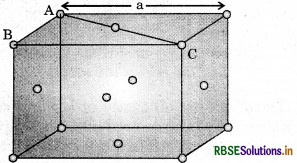
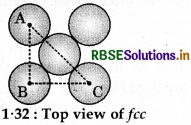
Unit cell edge length = a
Radius of sphere = r
Then in triangle ABC,
AC2 = AB2 + BC2
= a2 + a2
AC2 = 2a2
AC = \(\sqrt{2 a^2}\)
AC = \(a \sqrt{2}\)
But AC = 4r because three spheres are involved in AC as follow:

hence, 4r = \(a \sqrt{2}\)
and \(a=\frac{4 r}{\sqrt{2}}\)
volume of cube = (a)3
= \(\left(\frac{4 r}{\sqrt{2}}\right)^3\)
= \(\frac{64 r^3}{2 \sqrt{2}}\)
But the volume of one sphere having 'r' radius is \(\frac{4}{3} \pi r^3\)
We know that each unit cell in ccp structure has effectively 4 spheres. Hence total volume of four spheres is equal to \(4 \times \frac{4}{3} \pi r^3=\frac{16}{3} \pi r^3\)
Therefore,

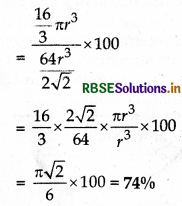
Thus, packing efficiency of hcp and ccp structures which is similar to face-centred cubic packing is 74%. While packing fraction is 0.74. Here 26% space is empty.
Packing Efficiency in Body Centred Cubic (bcc) Structure:
In body centred cubic structure, the sphere presentat the centre will be in touch with the other two atoms diagonally arranged as shown in fig. 1.46.
Let the edge length = a
Radius of sphere ar Then in triangle ABC,
AC2 = AB2 + BC
AC2 = a2 + a2
AC2 = 2a2

While body diagonal

But body diagonal is formed by touching three spheres, as follow:

hence,
AD = 4r
so,
AD = a\(\sqrt{3}\)
4r = a\(\sqrt{3}\)
hence,
\(a=\frac{4 r}{\sqrt{3}}\)
Volume of cube = (a)3
= \(\left(\frac{4 r}{\sqrt{3}}\right)^3=\frac{64 r^3}{3 \sqrt{3}}\)
But the volume of one sphere having radius 'r' is \(\frac{4}{3} \pi r^3\). We know that each unit cell in boc structure has effectively 2 spheres. Hence total volume of two spheres is equal to \(2 \times \frac{4}{3} \pi r^3=\frac{8}{3} \pi r^3\) Therefore,
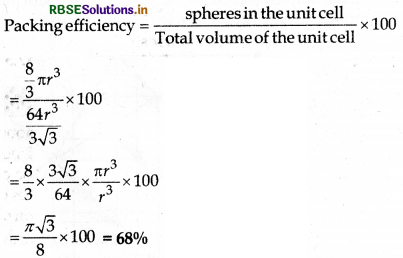
Thus, packing efficiency of bec structure is 68%. While packing fraction is 0.68. Here 32% space is empty
Packing Efficiency in Simple Cubic Lattice:
In a simple cubic lattice, the spheres are located only at corners of the cube. These spheres touch each other along the edge, which is shown in fig. 1.34.
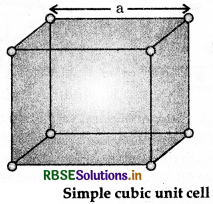
Let unit cell edge length = a
Radius of sphere = 1
If we look the top view of simple cubic unit cell then it will look as shown in fig. 1.35.
It is clear from fig. 1.35
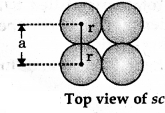
Edges length = 2r
a = 2r
Volume of cube = (a)3
= (2r)3
= 8r3
But the volume of one sphere having radius 'r' is imm We know that each unit cell in sc structure has effectively one sphere. Thus, total volume is also a
So,

= \(\frac{\frac{4}{3} \pi r^3}{8 r^3} \times 100\)
= \(\frac{\pi}{6} \times 100\)
= 52.4%
So the packing efficiency of sc structure is 52.4% while packing fraction is 0.524. Here 47.6% space is empty.

Question 1.11.
Silver crystallises in fee lattice. If edge length of the cell is 4.07 x 10-8 cm and density is 10.5 g cm-3. Calculate the atomic mass of silver.
Answer:
Given that, silver crystallises in fee lattice hence,
number of atoms per unit cell (Z) = 4
Edge length (a) = 4.07 x 10-8 cm
Density (d) = 10.5 g/ cm3
Avogadro's Number (NA) = 6.022 x 1023 mol-1
Atomic weight (M) = ?
Density of unit cell (d) = \(\frac{\mathrm{Z} \times \mathrm{M}}{(a)^3 \times \mathrm{N}_{\mathrm{A}}}\)
Hence M = \(\frac{d \times a^3 \times \mathrm{N}_{\mathrm{A}}}{\mathrm{Z}}\)
\(\begin{aligned} &=\frac{10.5 \times\left(4.07 \times 10^{-8}\right)^3 \times 6.022 \times 10^{23}}{4} \\ &=\frac{426.298}{4} \end{aligned}\)
= 106.57 g mol-1
Question 1.12.
A cubic solid is made of two elements P and Q. Atoms of Q are at the corners of the cube and P at the body centre. What is the formula of the compound ? What are the coordination number of P and Q?
Answer:
As Q atoms are arranged at the corners hence number of atoms of Q in the unit cell
= 8 (corners) x 1/8
= 1
As P atoms are arranged at the centre of body hence number of P atoms in the unit cell = 1
Formula of the compound = PQ
Coordination number of each P and Q = 8
Question 1.13.
Niobium crystallises in a body-centred cubic structure. If density is 8.55 g cm-3, calculate atomic radius of niobium using its atomic mass 93M.
Answer:
Given that, Niobium crystallises in bcc hence number of atoms per unit cell (Z) = 2Density d = 8.55 g/cm3
Atomic Weight (M) = 93 u
Avogadro Number (NA) = 6.022 x 1023 mol-1
Atomic radius = ?
\(d=\frac{\mathrm{Z} \times \mathrm{M}}{a^3 \times \mathrm{N}_{\mathrm{A}}}\)
or
\(8.55=\frac{2 \times 93}{(a)^3 \times 6.022 \times 10^{23}}\)
or
\(a^3=\frac{2 \times 93}{8.55 \times 6.022 \times 10^{23}}\)
= 3.613 x 10-23
or a3 = 36.13 x 10-24
Taking log on both sides,
log a3 = log 36.13 x 1024
or log a3 = log 36.13 + log 10-24
or log a3 = 1.558 - 24
or 3loga = -22.24
or log a = \(-\frac{22.442}{3}\)
or log a = -7.4806
or a = Antilog (-7.4806)
or a = 3.304 x 10-8 cm3
For bcc = \(r=\frac{\sqrt{3} a}{4}=\frac{\sqrt{3} \times 3.304 \times 10^{-8}}{4}\)
= \(\frac{1.732 \times 3.304 \times 10^{-8}}{4}\)
= 1.4306 x 10-8 cm
= 143.06 x 10-10 cm
= 143.06 pm
Radius of atom = 143.06 pm.
Question 1.14
If the radius of the octahedral void is r and radius of the atoms in close packing is R, derive relation between r and R.
Answer:
Octahedral void is shown in figure below. It is placed between four touching sphere in the form of small sphere. The two spheres present above and below the plane are not shown in the figure.
Let 'R' is the radius of sphere and V is the radius of void and 'a' is edge length.
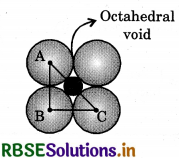
In right angle triangle ABC,
\(A C=\sqrt{A B^2+B C^2}\)
or
\(\mathrm{AC}=\sqrt{a^2+a^2}\)

but AC = 2r + 2r
Hence 2R + 2r = \(\sqrt{2 a^2}\)
2R + 2r = \(a \sqrt{2}\)
If a = 2R then,
or 2R + 2r = \(2 R \sqrt{2}\)
\(\frac{2 R}{2 R}+\frac{2 r}{2 R}=\sqrt{2}\)
or
1 + \(\frac{r}{\mathrm{R}}\) = 1.414
or
\(\frac{r}{R}=1.414-1\)
so, 
= 0.414
Question 1.15
Copper crystallises into a fee lattice with edge length 3.61 x 10-8 cm. Show that the calculated density is in agreement with its measured value of 8.92 g cm-3.
Answer:
Given that, copper crytallises into fee hence, number of atoms per unit cell 'Z' = 4
Edge length 'a' = 3.61 x 10-8 cm
Atomic weight 'M' = 63.5
Avogadro Number NA = 6.022 x 1023
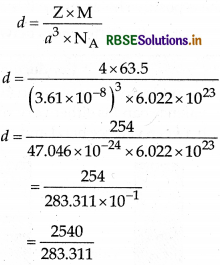
= 8.97 g cm-3
Hence, it is clear that the value of density is close to measured value.

Question 1.16
Analysis shows that nickel oxide has the formula Ni0.98 O100 What fractions of nickel exist as Ni2+ and Ni3+ ions?
Answer:
Ni0.98 O100
Let number of Ni2+ ions = x
Hence,number of Ni3+ ions = 0.98 - x
As the total charge on compound is equal to zero hence
charge on nickel ion = charge on oxide ion
2 x x + 3 (0.98 - x) =2
2x + 2.94 - 3x = 2
2x - 3x = 2 - 2.94
x = 0.94
Hence, fraction of Ni2+ ions = im x 100 = 96%
fraction of Ni3+ ion = 100 - 96 = 4%.
Question 1.17.
What is a semiconductor? Describe the two main types of semiconductors and contrast their conductors mechanism.
Answer:
Semiconductors: The substances whose conductivity lies in between conductors (metals) and insulators are known as semiconductors. The range of conductivity of semiconductors is from 10-6 to 104 Ω-1 m-1
Semiconductors are of two types:
(a) (a) n-type semiconductors : When higher group elements are doped as impurity then n-type semiconductors are formed. For example : Silicon and germanium belong to group-14 and they have four electrons in their valence shell. In crystal each atom forms four covalent bonds with its neighbours. When the elements of group 15 like phosphorus and arsenic are doped in silicon and germanium crystal then they occupy some of the lattice sites in silicon or germanium crystal, four out of five electrons are used in the formation of four covalent bonds with the four neighbouring silicon atoms or germanium atoms. The fifth free electron becomes delocalised and these delocalised electrons increase the conductivity of silicon or germanium.
As the conductivity increases due to the negatively charged electrons hence it is called as n-type semiconductors, fig 150.
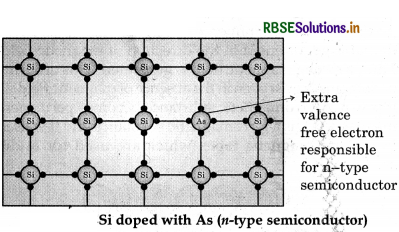
(b) p-type semiconductors: When lower group elements are doped as impurity, then p-type semiconductors are formed. For example: Silicon and germanium belong to group -14 and they have four electrons in their valence shell. In silicon crystal, each atom forms four covalent bonds with its neighbours. When the elements of group-13 like Galium (Ga) and Indium (In) are doped in silicon or germanium crystal, then they occupy some of the lattice sites in silicon or germanium crystals. The elements of group-13 have only three is missing is called electron hole or electron valency. The is missing is called electron hole or electron valency. The behind an electron hole at its original position. In this way under the influence of electric field, electrons would move towards the positively charged plate through electronic holes. At this time it would appear as if electron holes are positively charged and are moving towards negatively charged plate. These types of semiconductors are called p-type semiconductors, fig 151.
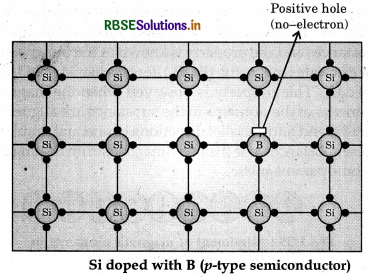
Question 1.18
Non-stoichiometric cuprous oxide, Cu2O can be prepared in laboratory. In this oxide, copper to oxygen ratio is slightly less than 2 : 1. Can you account for the fact that this substance is a p-type semiconductor?
Answer:
Since the ratio of Cu : O in Cu2O is less than 2 :1. It shows that some cuprous (Cu+) ions have been replaced by cupric (Cu2+) ions. For maintaining electrical neutrality, every two Cu+ ions will be replaced by one Cu2+ ion thereby creating a hole. As conduction will be due to the presence of these positive holes, hence it is a p-type semiconductor.
Question 1.19.
Ferric oxide crystallises in a hexagonal close packed array of oxide ions with two out of every three octahedral holes occupied by ferric ions. Derive the formula of the ferric oxide.
Answer:
Let the number of oxide ions in hexagonal close packed array = x
Number of octahedral voids = x 2
As 2/3 rd of the octahedral voids are occupied by ferric ions, hence, number of ferric ions present = 2/3 x
Ratio of ferric ions: oxide ions 2/3x : x
= 2 : 3
Hence, formula is Fe2O3.
Question 1.20.
Classify each of the following as being either a p-type or a n-type semiconductors:
1. Ge doped with In
2. Si doped with B.
Answer:
- Ge is group-14 element and In is group-13 element. Thus, an electron deficient hole is created and therefore, it is p-type semiconductor.
- Si is group-14 element and B is group-13 element. Thus, an elctron deficient hole is created and therefore, it is p-type semiconductor.

Question 1.21.
Gold (atomic radius = 0.144 nm) crystallises in a face-centred unit cell. What is the length of a side of the cell?
Answer:
For fcc, a = \(2 \sqrt{2} r\)
= 2 x 1.414 x 0.144
= 0.407 nm.
Question 1.22.
In terms of band theory, what is the diff-erence between
(i) a conductor and an insulator?
(ii) a conductor and a semiconductor?
Answer:
(i) Differences between a Conductor and an Insulator:
|
Counductor |
Insulator |
|
In insulator the energy gap between conduction band and valence band is very large. So the electron can not jump from valence band to conduction band. |
In insulator the energy gap between conduction band and valence band is very large. So the electron can not jump from valence band to conduction band. |
|
|
|
(ii) Difference between a Counductor and Semi Counductor
|
Counductor |
Semi Counductor |
|
1. In conductor, energy gap between conduction band and valence band is either very small or there is overlapping between conduction band and valence band. |
1. In semiconductor, the energy gap is larger than conductor but lesser than insulator. So on increasing temperature, electron can jump easily from valence band to conduction band. Thus, conductivity of semiconductors increases. |
|
|
|
Question 1.23.
Explain the following terms with suitable examples:
(i) Schottky defeat
(ii) Frenkel defect
(iii) Interstitials
(iv) F-centres.
Answer:
(i) Schottky defect: In this type of defect, equal number of cations and anions left its lattice site leaving behind a hole. It is common defect in ionic compounds of high co-ordination number, where both cations and anions are of the same size. For example: NaCl, KC1, KBr etc. Due to this type of defect, density of the crystal decreases and conductivity increases.
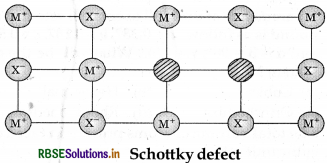
Frenkel defect:
(ii) Frenkel defect: In this type of defect, cation left its lattice site leaving behing a hole and it occupies the interstitial site in the crystal. It is common defect in those crystals where anion is much larger in size than cation. For example: AgCl, ZnS etc. Density of the crystal does not change in this type of defect but conductivity increases.

(iii) Interstitials : Atoms or ions which occupy normally vacant interstitials (voids) in a crystal are called interstitials. The defect arises due to transfer of atoms or ions into the interstitial voids are known as interstitial defects. This defect increases the density slightly.
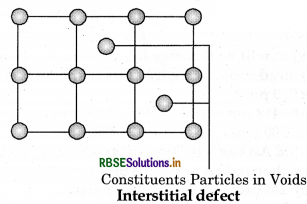
(iv) F-centres: When alkali metal halides are heated in an atmosphere of alkali metal vapour, anion vacancies are created. When the metal atoms deposit on the surface of alkali metal halide crystal, halide ion diffuses into the surface and combine there with metal atoms. The alkali metals ionize to produce electron which diffuse into crystal and combine with a negative ion vacancy. Electrons trapped in anion vacancies are called F-centres. This F- centre is responsible for colour in crystal. For example: Yellow colour of NaCl crystal is due to excess of Na+ ions. Violet colour of KCl crystal is due to excess of K+ ions.

Question 1.24.
Aluminium crystallises in a cubic close packed structure. Its metallic radius is 125 pm.
(i) What is the length of the side of the unit cell?
(ii) How many unit cells are there in 1.00 cm3 of aluminium?
Answer:
(i) For fee unit cell r = \(\frac{a}{2 \sqrt{2}}\)
Edge length 'a' = \(2 r \sqrt{2}\)
= 2 x 125 x 1.414 pm = 353.5 pm
= 353.5 x 10-10 cm
(ii) Volume of a unit cell = (a)3
= (353.5 x 10-10 cm)3
= 442 x 10-25 cm3
= 442 x 10-25 cm3 volume is of =1 unit cell
1 cm3 volume is of = imm
= 2.26 x 1022 unit cells.
Question 1.25.
If NaCl is dopped with 10-3mol% of SrCl2. What is the concentration of cation vacancies?
Answer:
As NaCl is dopped with 10-3mol% of SrCl2
i.e., 100 mol of NaCl is dopped with = 10-3 mol of SrCl2
1 mol of NaCl is dopped with \(=\frac{10^{-3}}{100}\) mol of SrCl2
= 10-5 mol of SrCl2
As each Sr2+ ion introduces one cation vacancy, therefore, concentration of cation vacancies are
= 10-5mol
= 105 x 6.02 x 1023
= 6.02 x 1018
Question 1.26.
Explain the following with suitable examples:
(i) Ferromagnetism
(ii) Paramagnetism
(iii) Ferri magnetism
(iv) Anti-ferromagnetism
(v) 12-16 and 13-15 group compounds.
Answer:
(i) Ferromagnetic substances: The substances, which have permanent magnetism even in the absence of the magnetic field, are called ferromagnetic substances. Forexampl : iop, cobalt, nickel, gadolinium and CrO2 etc. These sus1tndes are strongly attracted by the magnetic field. Besicles strong attractions, these substances can be permanently magnetised, because in solid state, metal ions of such substances are grouped together into small regions called domains. Each domain behaves as a tiny magnet with a definite magnetic moment. In an unmagneti sed piece of a ferromagnetic substance, the domains are oriented randomly so their magnetic moments get cancelled. On placing it under the influence of magnetic field then all the domains et oriented in the direction of magnetic field. Thus, a strong magnetic field is generated. This ordering of domains persist even in the absence of magnetic field: this way a ferromagnetic substance becomes permanent magnet. CrO2 isferromagnetic substance and it is used in making magnetic tapes which are used for audio recording
(ii) Paramagne’ic substances: The substances, which are attracted by the external magnetic field, are known as paramagnetic substances and the properties thus exhibited are known as paramagnetism. For example: O2, Cu2, Fe3, NO etc. The atoms of these substances have unpaired electrons. Thus, their magnetic moments due to spin may lead to the magnetic character. However their magnetism is lost in the absence of the magnetic field.
(iii) Ferrimagnetic substances: Substances which are expected to possess large magnetism on the basis of the magnetic moments of the domains but actually they have small net magnetic moment are called ferrimagnetic substances and the property is known as ferrimagnetism. For example: magnetite (Fe3O4), ferrites like MgFe2O4 and ZnFe2O4. This property is observed when the magnetic moments of the domains in the substance are aligned in parallel and anti-parallel directions in unequal numbers. These substances lose their ferrimagnetism on heating and become paramagnetic.
(iv) Anti-ferromagnetic substances: The substances, which are expected to possess paramagnetism of ferromagnetism on the basis of the magnetic moments of the domains but actually their net magnetic moment is equal to zero, are called anti-ferromagnetic substances. For exanple: MnO. The Anti-ferromagnetism in the substance is due to the presence of equal number of domains in the opposite directions and hence can cancel out each other’s magnetic moment.
(v) The compounds formed by the combination of the elements of group 12 - and group -16 are called 12-16 compound. Examples: ZnS, HgTe, etc. The compounds formed by the combination of the elements of group - 13 and group -15 are called 13 - 15 compounds. Examples: Ga As, AIP etc.

